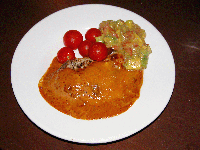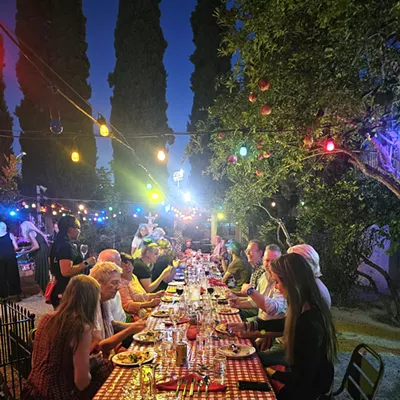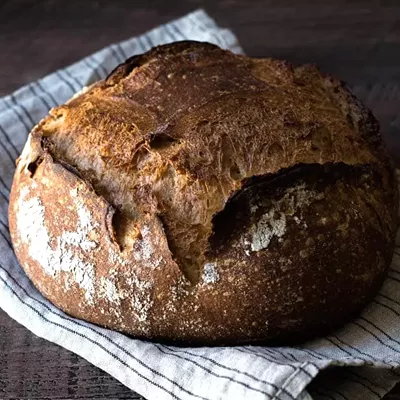For those of you who are already blessed with the knowledge, forgive this didactic excursion. Mole means "mixture" in Spanish. Guacamole is a perfect example, blending avocados, green chiles, tomatoes, onion, salt, lemon and whatever else may tickle your gustatory fancy. That is, in fact, the magic of moles: In addition to the classics you can look up online or in many cookbooks (mole poblano being best-known), moles are the product of the imagination and resources available to the person making them. Every mole will be different.
First and foremost are the chiles which are the base for the mole. The names themselves are poetry: pasilla, mirasol, cascabel de arbol. serranos, jalapenos, and ancho/poblano (depending on whether it is dried or fresh). tabasco, aji, cayenne, santaka, pekin, rocoto and chiltepin. Those are the best-known. The moles they become may be green, brown, yellow, red or black, sweet, hot or mild, rich with cream, chocolate-flavored, nutty and redolent with any kind of spice and herb from anise to thyme. Many mole recipes call for tortillas and bread to be added for flavor and thickening; others for fruit. Some moles take days to create, others very little time at all. A mole can be an inherited family treasure or based on the inspiration of a moment.
There are wonderful legends about moles. One version has it that mole poblano was first made in the 16th century by ingenious nuns in the convent of Santa Rosa in Puebla. Worried that their fare would be too simple for a visiting archbishop, they decided to chop up everything edible in the kitchen--including a piece of chocolate--to make a sauce for their solitary turkey. His Grace was, we are told, well-pleased. In another version of the story, a nun in the same convent worked to blend the spices and foods and the New and Old Worlds in a single dish to honor a visiting viceroy. In still another--and the one I like best--mole came to be when a sudden gust of wind blew through a kitchen window, mixing and swirling spices from open jars and dusting a bowl of casuela being prepared by a friar. Mole was, apparently, known and savored by the Aztecs long before the Old World came to this continent.
The best moles I have ever had have been those created by Susana Davila at her Café Poca Cosa (88 E. Broadway Blvd., next to the Clarion). Actually, I have never had anything NOT splendid at Poca Cosa. But, sitting here this afternoon, looking out at the Catalinas, I can actually taste in my memory the sharp, smoky chocolate of her pollo a mole--and that from years ago. The salsa at Poca Cosa is one of the best around; in years past, I would make sure to get a quart of it before she closed the restaurant for a month or so in the summer.
I have two moles I like to make, although they never are quite the same. The base recipes that follow are modified from Mexico the Beautiful Cookbook. The first is incredibly rich and easy to make, and is for chicken or turkey. The second, smoky, fiery and pungent, is usually for pork, although it works wonderfully with beef. Both are great accompanied by black beans with capers and garlic, and calabacitas. Flour tortillas and a solid red or cold beer are fine companions. And one of the convenient things about living in Tucson is that most grocery stores have a variety of dried chiles from which to choose.
Chicken Breasts in Poblano Sauce au Gratin
- Four boneless chicken breasts
- 1/2 cup milk
- Salt and freshly ground pepper
- 1/4 cup butter
- 3-4 chiles pasilla
- 1 cup thick cream
- 1 tablespoon all-purpose flour
- 6 tablespoon grated cheddar cheese
- Pine nuts
- 2 garlic cloves
Flatten each breast slightly and sprinkle with salt and pepper. Refrigerate while making the mole. Remove the stem, seeds and membranes from the chiles, and pureé in blender with the garlic, pine nuts and milk. If the chiles are dry, rehydrate first in hot water. Melt two tablespoons of the butter in a small saucepan. Sift the flour into the butter and stir until smooth. Add the chile pureé and stir. Add the cream and stir over low heat until the mixture boils and thickens. Remove from heat and add salt to taste. (This can be made up to six hours in advance and refrigerated; reheat before using.)
Preheat the oven to 350 degrees. Melt the remaining butter in a skillet, add chicken breasts and sauté for two minutes on each side. Transfer to a small baking dish, cover with the sauce, sprinkle with the cheese and bake for 10 minutes. Serves 2-3.
Beef With Chile Sauce
- 3 pounds boneless roast, cut into large cubes
- 3 tablespoons shortening
- 6 cloves garlic, minced
- 2 tablespoons all-purpose flour
- 3 chiles pasilla
- 4 cups hot water
- 1 chile habanero
- 2 teaspoons dried oregano
- 1/4 cup browned pine nuts
- 2 tablespoons white vinegar
- 1 teaspoon ground cumin
- 1 teaspoon sesame oil
- 1 tablespoon sesame seeds
Melt the shortening in a skillet over medium heat. When it is hot, add the meat, a little salt and the garlic. Sauté until the meat is cooked. Remove the stem, seeds and membranes from the chiles. If dried, rehydrate first. Soak the chiles in hot water for five minutes, then transfer the water and chiles to a blender and pureé with the flour, pine nuts, seeds, spices, oil and vinegar.
Pour the sauce over the meat and cook over low heat for 10 minutes. Stir to prevent sticking. Serves four.
Invent your own moles and traditions--that's at least half the fun. And let me know about your creations.







